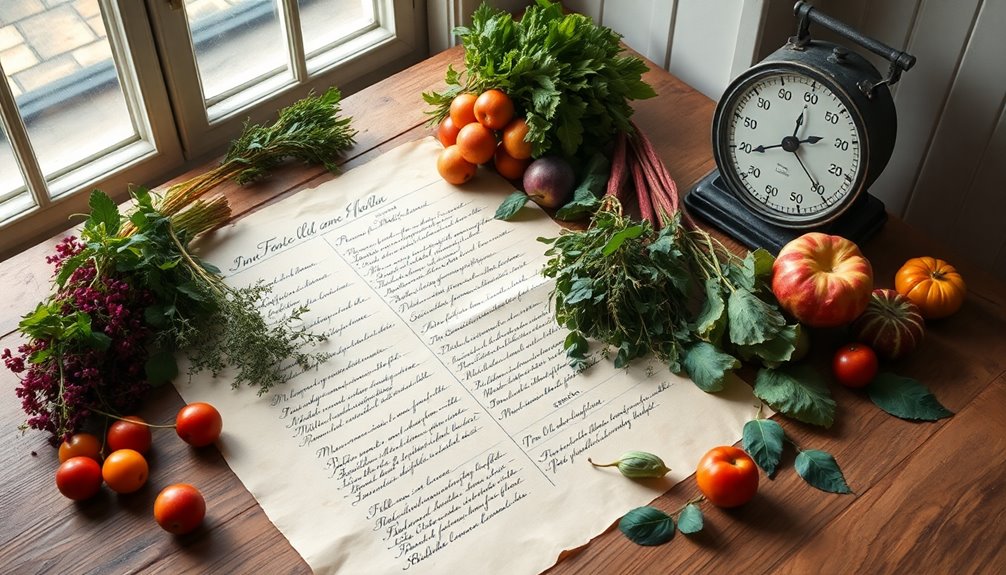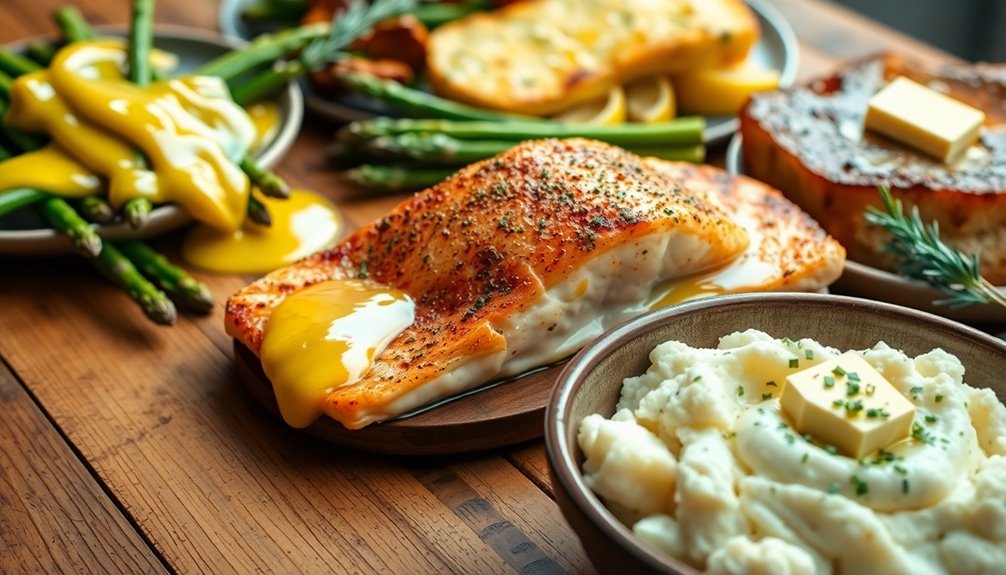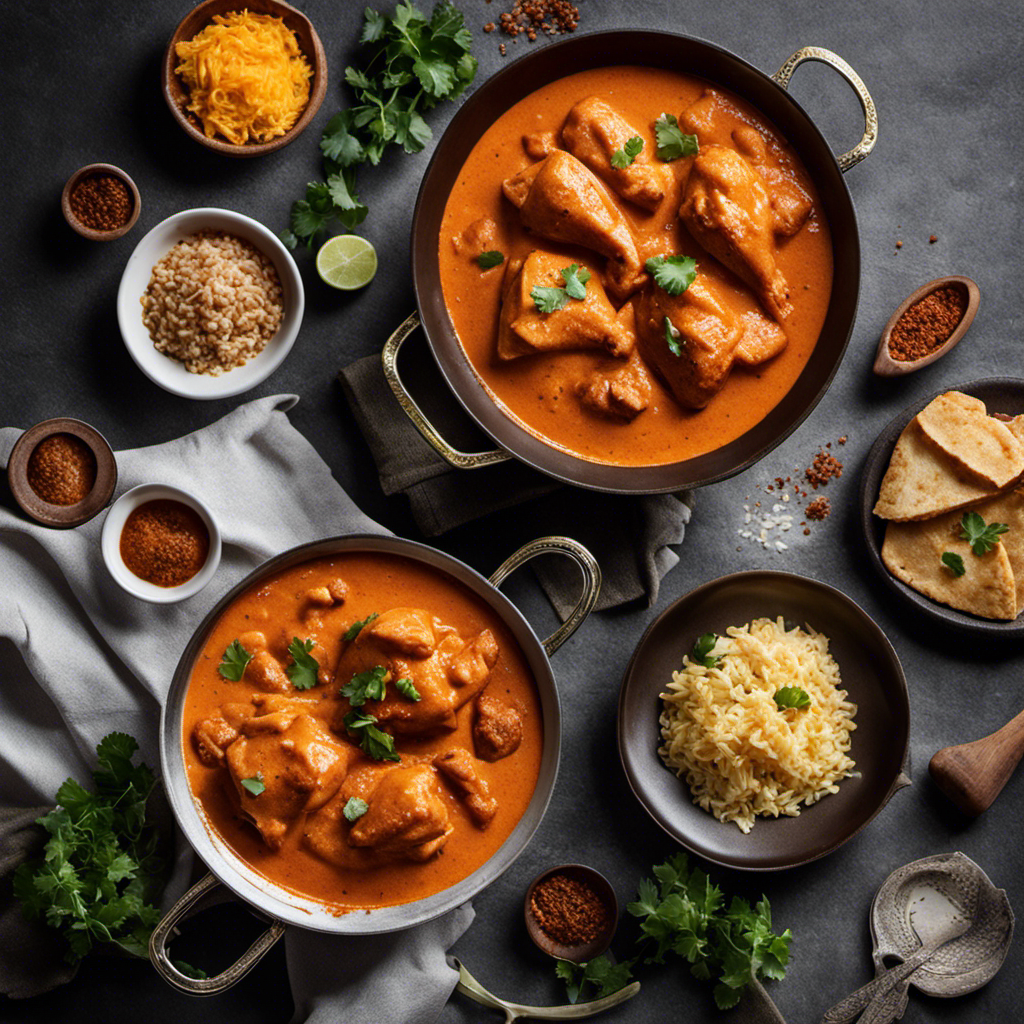Antique grocery lists are a fascinating way to reconnect with classic foods that promote modern health. By exploring these lists, you'll discover a variety of traditional ingredients, from lean meats to heirloom fruits, all known for their nutritional benefits. These timeless foods not only support wellness but also reflect sustainable eating practices, which can lower your risk of chronic diseases. Plus, the practical design of antique lists enhances your shopping experience and meal planning. If you're eager to revamp your kitchen routine with a touch of history, there's plenty more to uncover that can enrich your culinary journey.
Key Takeaways
- Antique grocery lists can guide the selection of nutrient-rich heirloom fruits and vegetables, promoting better health through traditional diets.
- Incorporating classic foods like lean meats and fermented items can enhance gut health and provide essential nutrients for modern diets.
- Utilizing antique lists encourages sustainable practices by supporting local farmers and reducing carbon footprints through local sourcing.
- Engaging family members in meal prep using antique recipes fosters cooking skills and promotes healthy eating habits across generations.
- Planning meals around seasonal produce and using antique lists can reduce food waste and encourage budget-friendly shopping practices.
Historical Significance of Grocery Lists
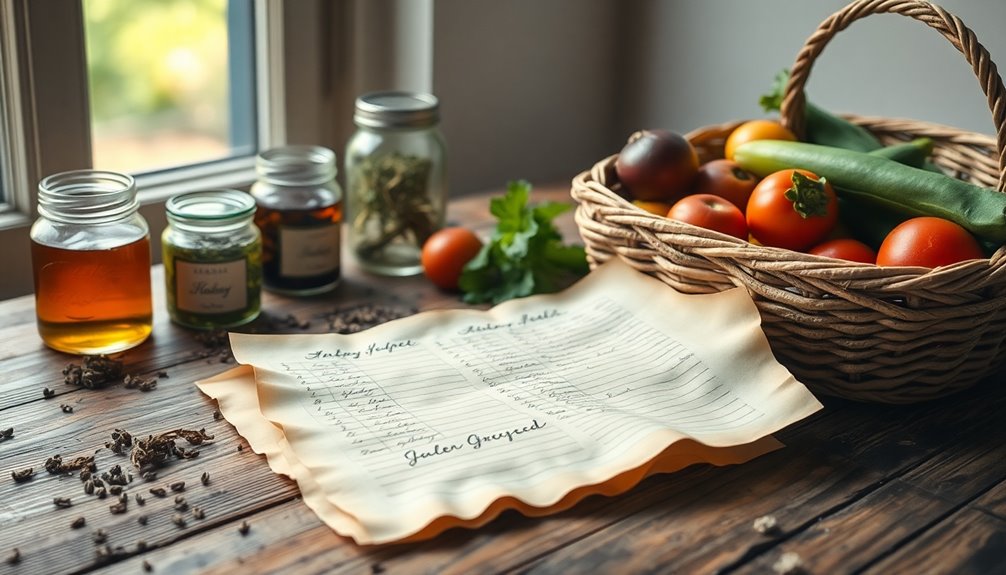
Although grocery lists may seem like a simple tool for modern shopping, their historical significance reveals much about past societies. You might be surprised to learn that grocery lists have existed in various forms since ancient times, from Mesopotamia to Rome.
In 17th-century England, lists found in homes like Knole in Kent show organized shopping practices, highlighting how people approached their dietary needs. These lists often included common items like food, spices, and household goods, reflecting the lifestyle of the time. Notably, the items on these lists, such as exotic spices, illustrate the growing diversity of available goods during this period. Moreover, the meticulous nature of these lists indicates an early form of content quality that ensured the efficient procurement of necessary items. Over time, the evolution of grocery lists also mirrored changing retail practices, emphasizing how consumer needs influenced shopping methods.
By studying them, you gain insight into consumer behavior and economic practices of the past. For instance, the availability of non-perishable goods from distant regions underscores the early stages of trade and globalization.
Before 1900, you'd have visited multiple specialty stores to gather your groceries. The introduction of economy grocery stores and self-service models transformed how you shop, marking a shift towards efficiency and autonomy.
As you explore the evolution of grocery lists, you'll see how these simple documents helped shape shopping practices, revealing a lot about social status, dietary habits, and even literacy rates throughout history.
The Unique Design of Antique Lists
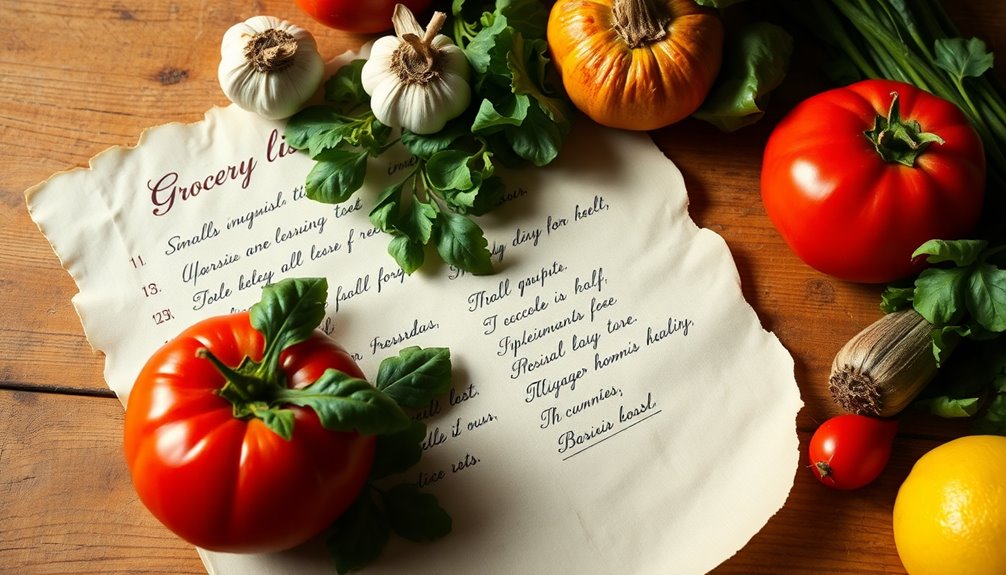
Antique grocery lists stand out not just for their historical importance but also for their unique designs that blend functionality with artistry. Crafted from durable metals like tin and steel, these lists often feature etched or engraved items, making them both practical and visually appealing.
You might find one hanging on your wall, easily accessible and visible, showcasing the elegance of vintage design. The design includes bendable metal tabs next to each item, allowing you to indicate when something is needed without the hassle of writing. Simply ensure all tabs point in the same direction during setup, and you're good to go!
These lists typically include pantry staples like bacon and catsup, reflecting the dietary habits of their time, though they may not cater to modern tastes. Mechanical shopping lists emerged in the 20s-40s as a solution to help shoppers avoid forgetting essential items. Aesthetic appeal is another key aspect; vintage fonts and illustrations enhance their charm, making them a delightful addition to any kitchen or pantry.
You can discover these treasures at flea markets or online, where they serve not just as functional tools but also as nostalgic conversation pieces, encapsulating a slice of culinary history.
Practical Uses in Modern Kitchens
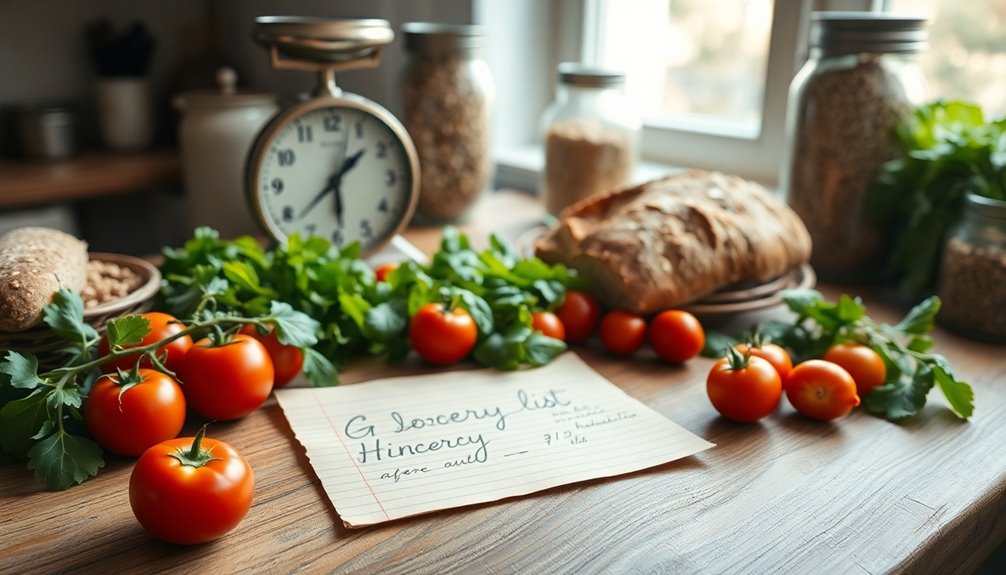
Vintage grocery lists aren't just relics of the past; they offer practical benefits in today's kitchens. These antique metal shopping lists come equipped with pre-etched categories and bendable tabs, allowing you to track depleted supplies effortlessly. When you need to restock, simply bend the tabs in different directions to indicate what's missing. This system streamlines your shopping experience, enabling quick identification of necessary items without the hassle of rewriting your list each time. Additionally, using a Master Grocery List can further enhance your shopping efficiency by ensuring you don't forget essential items. Incorporating aesthetic hooks in your kitchen can also provide a functional space for hanging these lists, merging organization with style. Furthermore, using open shelving in your kitchen allows easy access to frequently used items, complementing the use of vintage lists.
The incorporation of natural elements into your kitchen design can also create a calming environment that complements your vintage decor. You can easily integrate these lists with modern grocery methods, like bullet journals, making them versatile. Add non-standard items or personal notes, adapting the list to fit your household's unique needs. Implementing organized zones for different grocery categories can also simplify the shopping process. Effective wall organization can reduce clutter and promote order, making your kitchen more efficient.
Beyond their functionality, vintage lists add a touch of nostalgia to your kitchen decor. Hang one on the wall, and it becomes an attractive conversation piece while enhancing your retro theme.
Ultimately, these lists help you remember essential items, reduce forgetfulness during shopping trips, and maintain a well-stocked pantry, allowing you to streamline your grocery runs and avoid unnecessary purchases.
Rediscovering these classic tools can elevate your kitchen organization while celebrating the past.
Meal Planning Strategies for Families
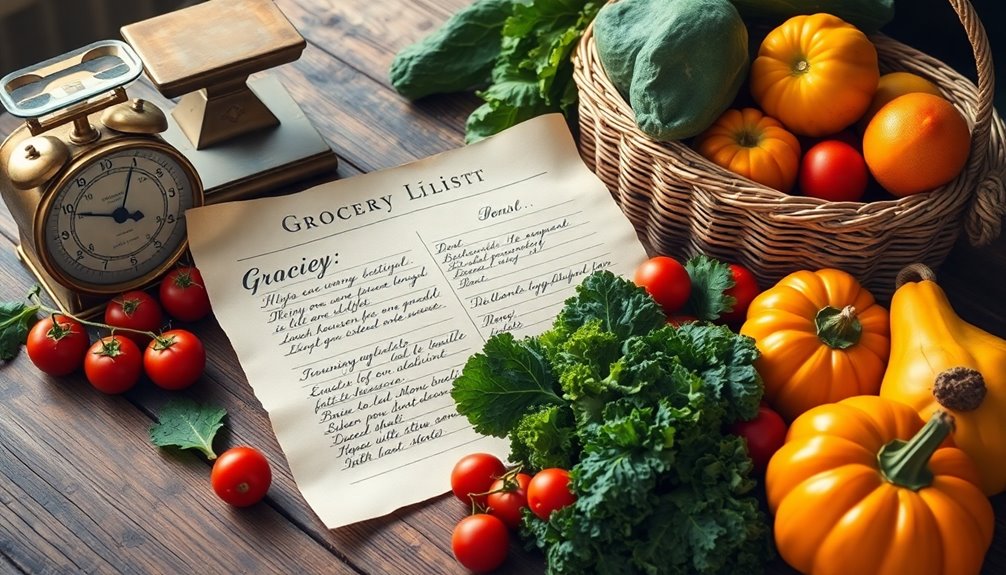
Effective meal planning can transform your family's dining experience and make weeknight dinners less stressful. Start by determining your family's schedule and meal needs for the week. Identify how many meals and snacks you'll need, factoring in breakfast, lunch, dinner, and any meals eaten away from home.
Create a list of preferred foods and new recipes to try, ensuring you consider dietary needs and nutrient balance. Incorporating high omega-3 content from foods like chia seeds can enhance your family's meals while providing essential nutrients. Baked kale is another nutritious option that can be included, as it retains essential vitamins and minerals. Additionally, including beet juice in your family's diet can support overall wellness and improve blood flow. Regular grooming can also minimize pet hair, which may be helpful if you have pets at home. Meal planning strategies help optimize grocery spending, making it easier to stay within budget.
Next, adapt your meal plans to your family's busy days. Schedule quick or pre-cooked meals for hectic times, and don't forget to utilize pre-frozen meals or leftovers. Incorporate "fridge-raid" meals to use up what you already have, and stay flexible to accommodate unexpected changes.
Organize your meals by creating a bank of easy, go-to recipes, and check your pantry, freezer, and fridge for existing food. Plan meals based on grocery store sales and make a detailed shopping list from your meal plan.
Finally, involve your family in the process—assign different meal prep duties, allow kids to help plan a meal, and post your meal plan on the refrigerator to keep everyone informed and engaged.
Budgeting Tips for Grocery Shopping
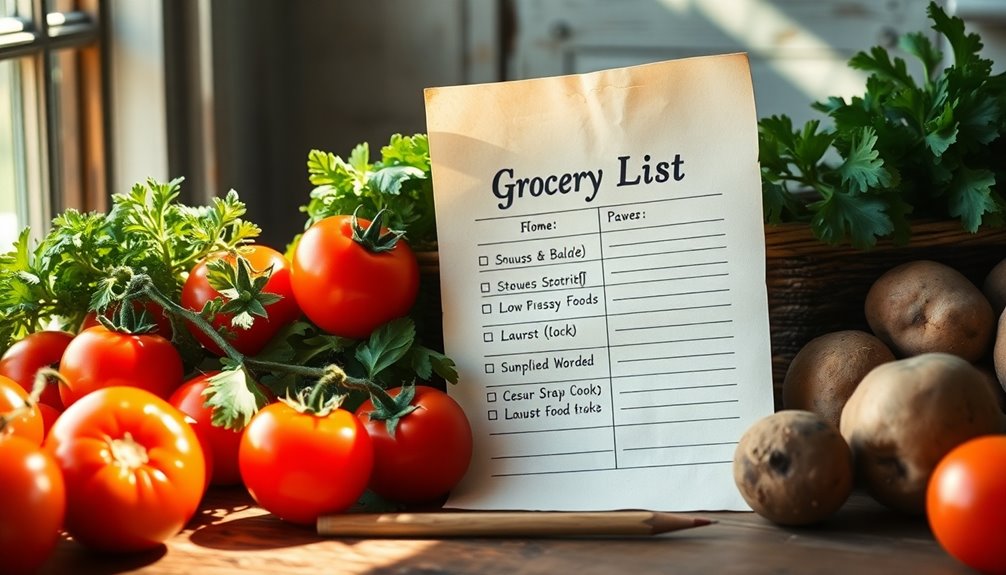
When it comes to grocery shopping, sticking to a budget can make a significant difference in your overall spending. Start by allocating a percentage of your income for groceries, ideally following the 50/30/20 rule where 50% of your budget covers needs like groceries. The average monthly grocery cost is $504 for general consumers, highlighting the importance of effective budgeting. Including nutritious breakfast options can also help you make healthier choices while staying within your budget.
Track your current spending to identify patterns and adjust your budget based on your actual habits. To streamline your shopping, organize your grocery list by store categories, and use a template or app to categorize items according to the layout of your favorite store. Be specific about each item, including brand names and quantities, to avoid impulse buys. Additionally, setting a budget helps prevent unplanned expenses, much like how RMDs must be calculated to avoid tax penalties. Maintaining a clear budget aligns with the importance of a personal budget in achieving financial health.
Utilize cost-saving techniques such as buying in bulk for non-perishables and opting for store brands. Purchasing seasonal and local produce can also lower costs. Always compare prices by checking the cost per unit.
Take advantage of sales and stock up on frequently consumed items when prices drop. Use rebate apps, sign up for loyalty programs, and embrace the bulk section for additional savings. Preserving food can reduce waste and help you save on future purchases.
Involving Family in Grocery Tasks
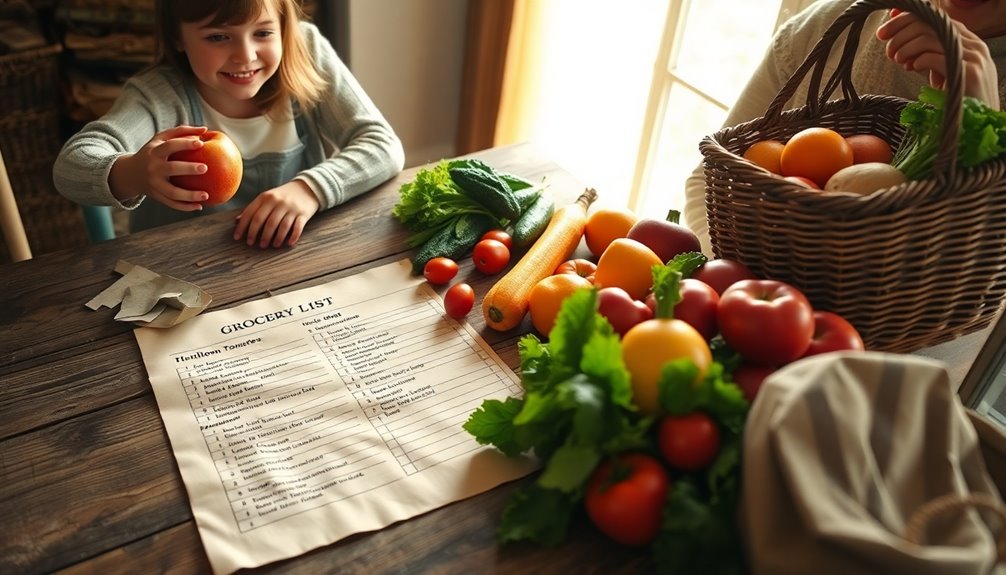
Involving your family in grocery tasks can turn a routine chore into an enjoyable and educational experience. When you take your children shopping, you teach them essential life skills like meal planning and food preparation. They'll see how raw ingredients transform into meals, gaining a better understanding of the food process. Additionally, engaging in grocery lists can streamline shopping and help them learn budgeting skills. Incorporating healthy ingredients like those found in unique beetroot recipes can inspire creativity in meal preparation. Furthermore, discussing survival gear items can spark interest in nutritious foods that contribute to overall health. Regular visits to the store can also help children experience socialization opportunities similar to those recommended for puppies, enhancing their adaptability in various situations. Exploring fresh produce, such as Easy Tomato Focaccia ingredients, can also encourage kids to try their hand at baking.
Plus, they can practice reading labels and comparing nutrition information, which helps them make smarter food choices.
Encouraging your kids to help with grocery shopping also promotes healthy eating habits. When they're involved in selecting food, they're more likely to try new items and develop a broader culinary palate. Discussing healthy options reinforces positive eating behaviors at home and in the store.
Grocery shopping together fosters family bonding and responsibility. Children feel a sense of ownership over the foods they help choose, and you can assign simple tasks like bagging items or finding specific products. This teamwork builds trust and empowers your kids to make healthy decisions.
Lastly, grocery stores provide sensory experiences for children. They can explore sights, smells, and textures, making the shopping trip both fun and educational while practicing patience and politeness in a low-stakes setting.
Classic Foods for Modern Health
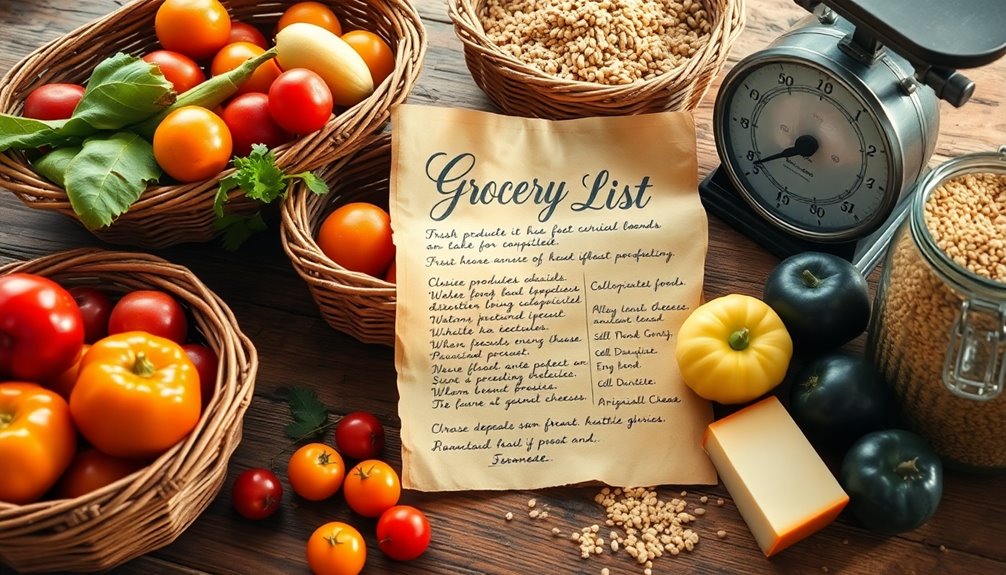
Classic foods have stood the test of time, offering nutritional benefits that align perfectly with modern health needs. By incorporating traditional ingredients into your diet, you can enjoy fewer calories and less saturated fat, which helps keep your heart healthy.
Opt for lean meats and fish, as they provide essential proteins, iron, and zinc that boost muscle strength and enhance wound healing. Traditional foods are often high in omega-3 fatty acids, especially from marine sources, which contribute to heart health.
Fermented foods like kimchee, kefir, and sauerkraut are excellent choices for gut health. They're rich in probiotics, which support digestion and strengthen your immune system.
Bone broth, packed with calcium, magnesium, and collagen, can improve bone and joint health while promoting glowing skin and strong nails.
You'll also benefit from using whole, unprocessed ingredients that maintain nutritional integrity, allowing you to absorb more vitamins and minerals.
Traditional cooking methods, as seen in many African and Asian dishes, help preserve these nutrients.
Lastly, don't forget about adding locally-sourced whole grains to your meals for added fiber and a diverse nutrient profile.
Embracing these classic foods can lead to a healthier, more balanced lifestyle.
Nostalgia Meets Contemporary Convenience

How does nostalgia influence your shopping habits today? You might find yourself reaching for familiar brands that remind you of carefree childhood days. The resurgence of products like Twinkies, Dunkaroos, and French Toast Crunch taps into your longing for those simpler times. Retailers are catching on, creating dedicated sections for these nostalgic items, both online and in-store, making it easy for you to find them.
During the pandemic, comfort food became a priority, and you likely embraced nostalgic snacks that spark joy and familiarity. With the rise of personalized e-commerce, searching for beloved classics is just a click away. This has led to a notable return of 1990s food items that resonate with consumers' emotional needs. The continued interest in personal development has also encouraged individuals to seek out foods that evoke joyful memories, further influencing their shopping choices. Many people turned to fried catfish and other traditional comfort foods that remind them of family gatherings and cherished moments. In line with this comfort-seeking behavior, many opt for high-quality protein sources to support overall health while indulging in nostalgic meals. Incorporating vitamins A, C, and K from fresh produce can enhance the nutritional value of these meals.
You can integrate these nostalgic foods into your meal planning, blending the old with the new, and satisfying your cravings while exploring fresh ideas. Consumers today crave a balance between nostalgia and innovation, so you're not alone. Brands like Chef Boyardee and Capri Sun remain staples because they offer both comfort and familiarity.
As retailers continue to highlight these nostalgic favorites, you can enjoy the convenience of modern shopping while indulging in the flavors of your past. It's a delightful way to nourish both body and soul.
Frequently Asked Questions
Where Can I Find Antique Grocery Lists for Sale?
You can find antique grocery lists for sale in several places.
Start by browsing online marketplaces like Etsy and eBay, where vintage items are often listed.
Check out local flea markets, garage sales, and vintage shops for unique finds.
Antique fairs and local auctions might also have what you're looking for.
Keep an eye out for specific types, like metal or wooden lists, as they add charm to your collection.
How Do I Clean and Maintain an Antique Grocery List?
To clean and maintain an antique grocery list, start by gently wiping it with a soft, dry cloth to remove dust.
If the paper's stained, use a slightly damp cloth, but avoid soaking it.
Store it in a cool, dry place away from sunlight to prevent fading.
Consider using acid-free archival materials for protection.
Handling it carefully will help preserve its condition, ensuring it lasts for years to come.
Are Antique Grocery Lists Safe to Use for Food Tracking?
Antique grocery lists aren't safe for food tracking. They lack features like expiration tracking, allergy alerts, or the ability to adapt to dietary restrictions.
The metal materials may rust and are hard to clean, posing hygiene concerns. Plus, without technological integration, you can't easily manage your shopping or meal planning.
If you're serious about tracking your food intake, you'd be better off using modern methods that cater to your specific nutritional needs.
Can I Customize an Antique Grocery List for My Needs?
You can't really customize an antique grocery list to fit your needs. These vintage lists are often fixed with specific items and mainly serve decorative purposes.
However, if you want to tailor your shopping experience, consider using printable templates or notepads designed for modern grocery lists. They allow you to add personal preferences, organize by store layout, and even plan meals for the week, making your shopping trips more efficient and enjoyable.
What Materials Were Antique Grocery Lists Typically Made From?
Antique grocery lists were typically made from a variety of materials.
You might find them crafted from durable metal, which often featured bendable tabs.
Wood was another popular choice, providing a rustic appeal and sometimes including pegs for hanging.
Paper and pads were common too, offering portable options for jotting down items.
Mixed materials, combining metal and wood, added both durability and style, often incorporating magnets for easy attachment to surfaces.
Conclusion
By embracing antique grocery lists, you not only connect with history but also elevate your modern cooking. Incorporating classic foods into your meals can boost your health while creating a sense of nostalgia. With practical strategies for meal planning and budgeting, you can involve your family in the process, making grocery shopping a fun and collaborative experience. So, why not rediscover the joy of classic foods and enjoy a healthier lifestyle today?
